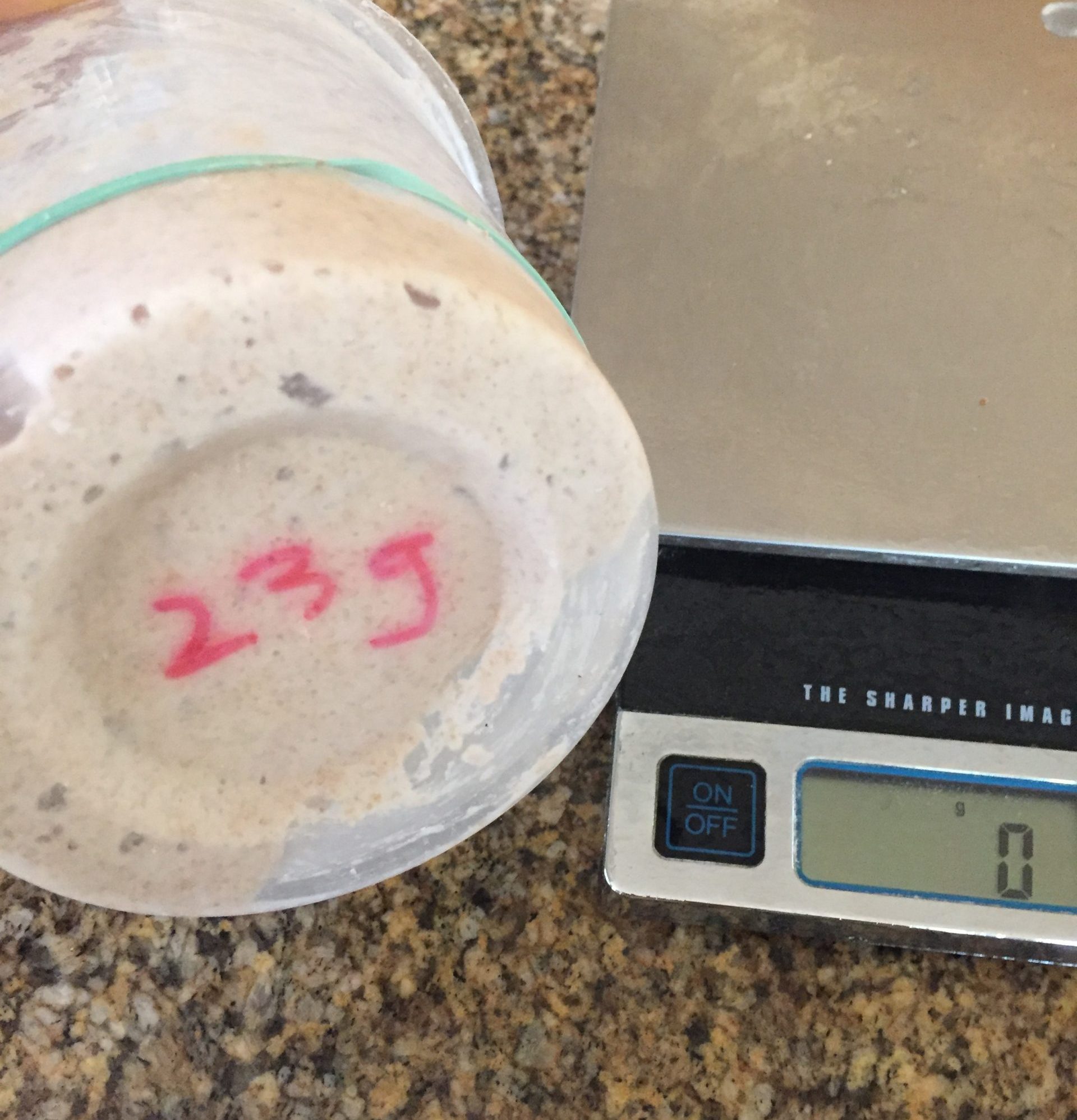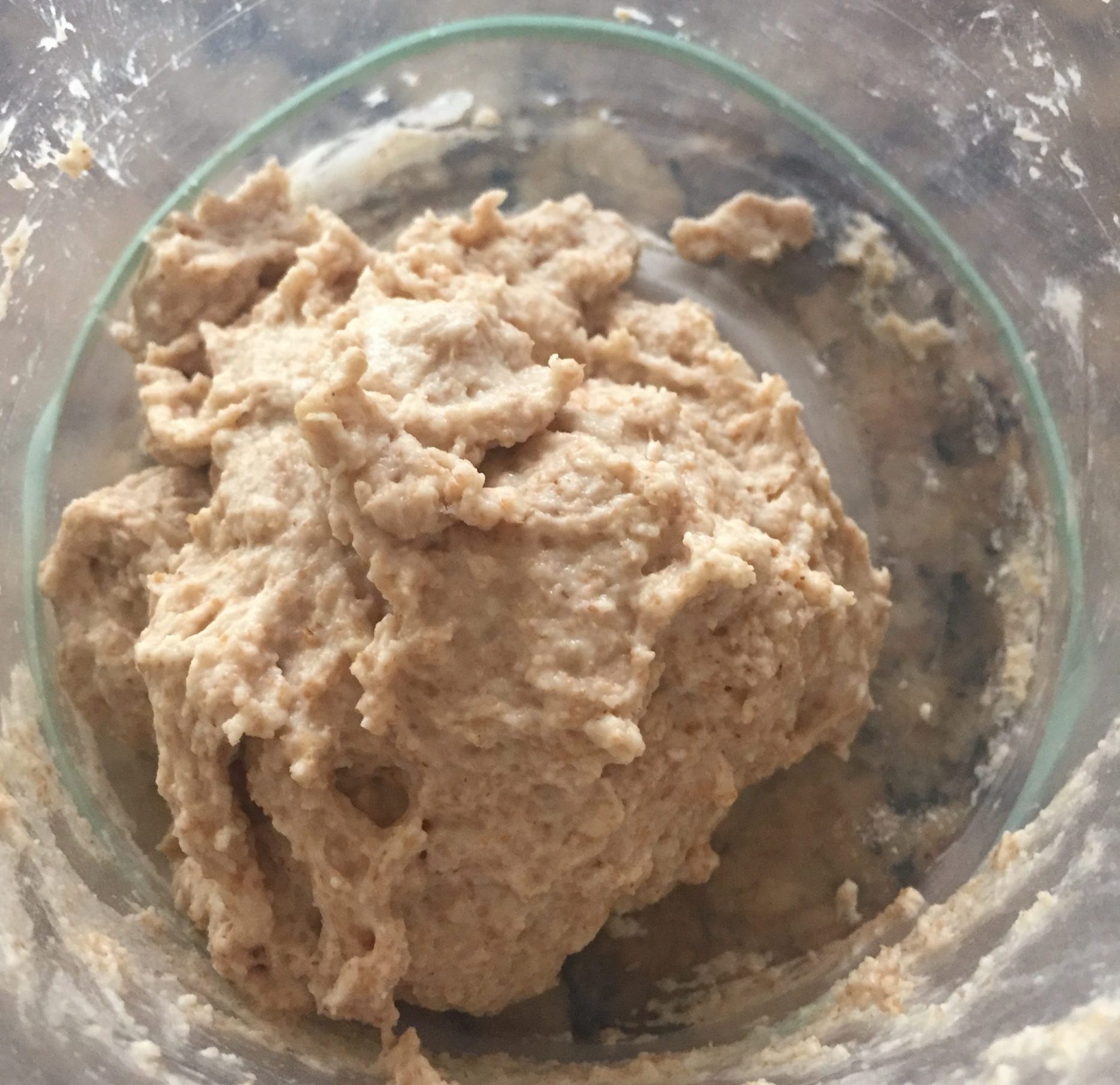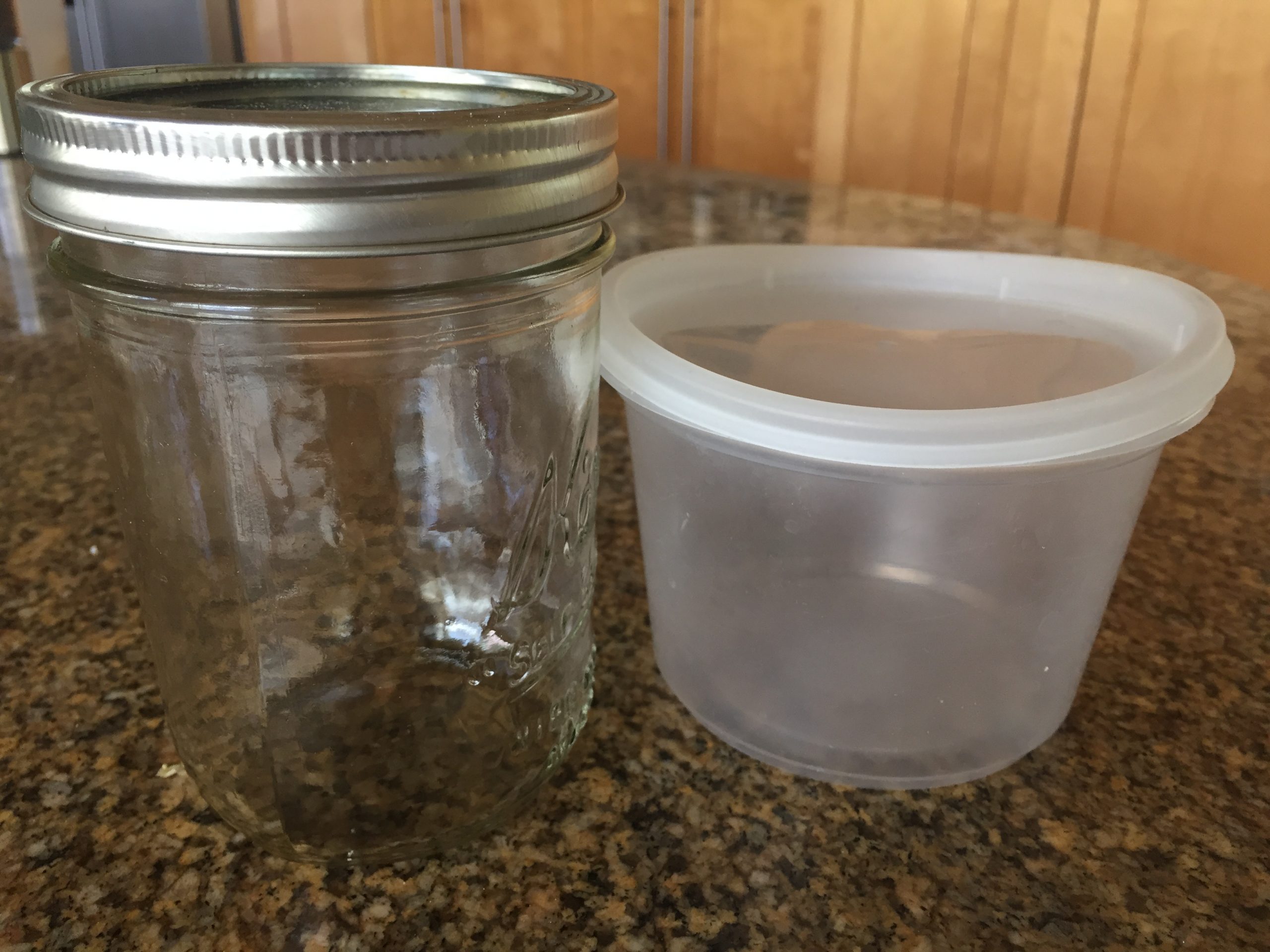Maintaining the starter, making the levain
What is a starter? What is a levain? Some recipes use the word starter and levain interchangeably. Both are made up of flour, water and wild yeast. However, I think of my sourdough starter as the mother dough from which I make the levain. The starter is usually the mixture that is maintained over time. When the starter is ripe, it is then a levain or pre-ferment. A levain is made from the maintained starter and developed the night before or the same day that the bread is made. The microbes of the levain are very active and at their peak when used as the leavening agent for baking sourdough bread. Use plastic containers with lids with the weight of the container written with permanent marker on the underside to make measuring and calculating the weights easier. Mason jars can also be used, but I prefer the plastic containers.
If you are using MY starter recipe, you will have about 80 grams of sourdough starter. In order to maintain the starter, you will need 20 grams for the Mother, resulting in 60 grams of starter to be used for levain or discards.
Calculating the amount of starter in your container.
- Weigh the starter in the container.

Subtract container weight.
- Subtract the weight of the container from the total weight. (I always write down the weight of the container on its underside with a permanent marker.) From the example above:
- the weight of my starter and container = 109 g.
- the weight of my container = 23 g.
- the weight of starter 109 - 23 = 86 g
- If you don't know the weight of your container, you can just weigh your starter in another container.
Once we know the amount of starter in the container, 20 grams of that will be used as the "mother" and the rest will be used for the levain or a recipe using discards.
I always have about 80 grams of starter on hand at any given time. I only need 20 grams of the starter for feeding and maintenance.
- I always keep and maintain 20 grams of starter in the original container so I remove enough starter until the scale measures 43 grams.
- the weight of my container = 23 g.
- the weight of starter to maintain = 20 g
- the weight of my starter and container 23 + 20 = 43 g.
- Add 37 grams of flour blend (50% bread flour and 50% whole wheat flour)
- Add 25 grams of filtered, room temperature water.
- Mix using your hands until the water and flour is completely incorporated and is a thick paste.
- Cover with tight lid and refrigerate.

Making the levain
If your starter is not active and has been sitting in the refrigerator for more than 4 days, I highly recommend feeding and refrigerating your starter the day before making a levain.
With 80 grams of starter, there are 2 options to proceed.
Option 1: Make levain without starter included. 2 plastic containers required
- Keep 20 grams of starter in the original container for starter maintenance. Feed that starter with above water and flour mix proportions.
- Place the rest of the sourdough in a second plastic container to be used for making the levain. Measure the weight of the sourdough starter in this second container. Determine the amount of pre-ferment that needs to be made by subtracting the sourdough starter you have on hand from the levain required in the recipe.
If your recipe calls for 100 grams of levain:- the weight required in the recipe= 100 g
- the weight of current starter = 60 g
- the weight of additional levain needed 100 - 60 = 40 g
- Because we use a 100% hydration when making our levain, equal amounts of flour mix and water are needed to make your additional levain. Divide the amount of additional levain required by 2 to get the amount of flour mix and water. From our example:
- the weight of additional levain needed = 40 g
- the weight of water and flour mixture = 40 ÷ 2 = 20 g
- Add 20 grams flour mix and 20 grams of water to your container and mix with your hands.
- Cover the container with a lid and let it rest for 6-12 hours in a 75 fahrenheit /24 Celcius environment. You can take a sharpie or elastic band and mark the original level. The pre-ferment should have doubled or tripled in size and looks like this. The smell would have also changed from a pungent to a sweeter smell. You can now use this levain for any sourdough recipe.
Option 2: Make levain with starter included (1 plastic container required)
- Weigh the starter on hand. For example
- the weight of my starter and container = 103 g.
- the weight of container = 23 g
- the weight of my starter = 109 g - 23 g = 80 g
- Determine the amount of pre-ferment needed plust 20 grams as the "mother". If your recipe calls for 100 grams of levain and 20 grams needed for "mother" starter.
- the weight required in the recipe plus "mother" starter= 100 g + 20 g (120 g)
- the weight of current starter = 80 g
- the weight of additional levain needed 120 - 80 = 40 g
- Because we use a 100% hydration when making our levain, equal amounts of flour mix and water are needed to make your additional levain. Divide the amount of additional levain required by 2 to get the amount of flour mix and water. From our example:
- the weight of additional levain needed = 40 g
- the weight of water and flour mixture = 40 ÷ 2 = 20 g
- Add 20 grams flour mix and 20 grams of water to your container and mix with your hands.
- Cover the container with a lid and let it rest for 6-12 hours in a 75 fahrenheit /24 Celcius environment. You can take a sharpie or elastic band and mark the original level. The pre-ferment should have doubled or tripled in size and looks like this. The smell would have also changed from a pungent to a sweeter smell. You can now use this levain for any sourdough recipe.
- Leave 20 grams of ripe starter / levain in the plastic container and feed and refrigerate it for future use. Use the remainder for the bread recipe.
Sourdough Basics
Step-by-step guide to making bread
This sourdough glossary will help you understand some of the terminology used
Here are some essential utensils and tools for sourdough baking. These basic
Baker's percentages and hydration percentages are two math concepts that are helpful
Environment It took me a while to figure out how my environment
What is a starter? What is a levain? Some recipes use the
Making GOOD and healthy sourdough bread is a labor of love. It
Many people think that scoring your sourdough is just for aesthetic purposes.
Many sourdough starter recipes out there are derived from professional bakers who
What is a starter? What is a levain? Some recipes use the
Sourdough Techniques
How To's
Many people think that scoring your sourdough is just for aesthetic purposes.
Get the latest tip & trick!
Subscibe to my Youtube Channel
Organic stoneground sourdough flax and chia bread has become one of my go-to breads, now that I've figured
Just in time for the big Holidays where this golden bliss sourdough cornbread is a great side and
Growing up in South Africa, one of my family's favorite baked goods besides Black forest cake was Boston
Growing up in South Africa, Easter was a big thing. I went to an Anglican all-girls school that
In my "previous life," before the internet, I sourced ingredients for food manufacturers and bakeries. One of my
I distinctly remember the first time I had a double chocolate chip cookie. It was at a cookie
Get the latest scoop!
Never miss another new recipe or tip & trick.

